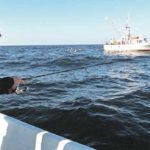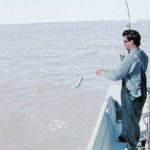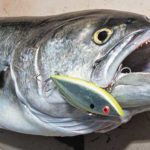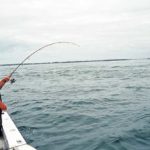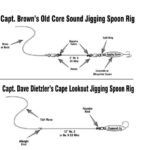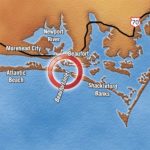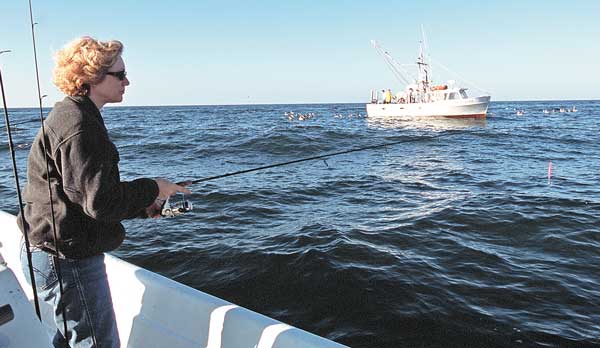
Morehead City anglers risk freezing weather to catch chopper blues.
By December many anglers have given up fishing inlets, bars and artificial reefs. They think cold weather means schooling fish have gone south or to the Gulf Stream to find warmer havens.
But for those looking for non-stop biting action, it’s one of the best times of the year. Two such anglers are Capt. Dave Dietzler and Capt. Charles Brown.
“You might be risking a case of blue lips,” Dietzler said. “But it’s worth it for bluefish action.
“December is actually one of our calmest months when it comes to weather; there are days when the air temperature gets into the 60s and even the 70s. When the water temperature drops sometime in December, sending most of the summer fish away, there are always some bluefish around.”
Dietzler picks up his clients at the Morehead City waterfront, then heads for Beaufort inlet a few miles away. He likes leaving early, because that’s when the birds start feeding.
“The first thing to watch for is the birds,” he said. “Find the birds, find the bluefish. They eat the same things.
“The water is very clear in December, and the birds can spot a school of baitfish way down beneath the surface. They’ll follow that school until it comes close enough to the surface for them to catch a few. Their feeding drives the baitfish back down and the bluefish drive them back up like a yoyo.”
Being there early is the best way to get in on the fastest action. Once the birds have had their fill, they go to rest along the shoreline of Cape Lookout.
“If the water stays warm, the bluefish may stick around the Cape, the shoals and the east beach into early December,” Dietzler said. “But the best fishing will usually be a bit farther offshore.
“I watch for birds and feeding bluefish on the way out, but I usually wind up at one of the structure areas. I like fishing for bluefish on the offshore reefs. The George Summerlin (AR 285, 24°33.383’/076°26.35′) and Atlas Tanker (34°32.171’/076°14.811) and 30-Minute Rock (34°32.690’/76°24.090′) are some of my best spots.”
Dietzler said he is also watching for breeching bluefin tuna. Bluefish are one of the top baits the big rigs use while trolling for bluefin, so finding an active school of the super-sized bluefin is an excellent indication bluefish are near.
“In the inlet, I use a speck rig, jig with a soft plastic (trailer) or whatever I happen to have tied on the line when I’m looking for false albacore, red drum or specks,” Dietzler said. “But once I locate bluefish, or if I don’t find them and head out for the deeper water, I switch to a Hopkins, Stingsilver or Diamond Jig. I want metal in the water if the bluefish are biting.
“At the reefs, the jigging spoons also catch amberjack, gray trout and other fish. But the smaller fish, like gray trout, are never going to make it to the surface without the bluefish chopping them up.”
Dietzler uses a metal leader as well, tying an Albright Special knot to secure a foot-long length of No. 5 or No. 6 single-strand wire to the line. He doesn’t use a swivel because a bluefish could mistake it for prey and bite right through the line.
“Any medium spinning rig will work,” he said. “I think a 15-pound test mono line on a 5000 series Penn 560 reel is perfect when it’s sitting on a 6 ½- to 7-foot rod.”
Diezler watches his depth-finder at all times when he’s looking for bluefish. If they are deep, he ties a chum bag over the side to bring them up.
“A bluefish is a sucker for chum,” he said. “If they’re scattered or deep, or if they are on a bar and you want to bring them out of the whitewater closer to the boat, chum is the way to lead the fish to your lure.”
Ready-made chum also works well. Sometimes commercial boats cull their catches, and birds are attracted to the easy meal as well as predatory fish, such as bluefish. In a pinch, Dietzler switches to using cut baits, which mimic shrimp-net cull.
“Any cut fish will attract a bluefish,” he said. “There are always some menhaden around the inlet, so if you see them, you should catch them with a cast net. Casting them around the commercial boats is a sure way to get attention from bluefish.
“Out on the reefs, bluefish are feeding on pinfish. If you can drop a Sabiki rig down and get it back up without the bluefish eating everything hanging on the rig on the way back up, it’s a great way to collect some live bait. I just put a chunk of bait on a long-shank No. 2 hook with a wire leader and free-line it.
“If you have someone who can’t cast far or if you get tired of jigging, using cut baits can bring action that is just as fast as spoons, if not faster. A bluefish never turns down a cut bait.”
Dietzler said an increasing number of his clients said they want to catch bluefish. He said it’s surprising because a bluefish is a sporty fish when hooked on light tackle.
“Bluefish are the hardest fighting fish around,” he said. “They leap and turn back-flips, taking off with sizzling run after sizzling run. They’re also getting bigger. We’re seeing more fish than ever weighing 10 or 12 pounds, but the biggest fish show up in spring.”
Brown agreed. A fourth-generation fishing guide, he said he never tires of catching bluefish.
“They’ve really made a comeback,” he said. “We used to catch the little dinks. But now, a good catch of 3-pounders is common and we routinely catch big 12-pounders in the spring. In December we catch lots of the smaller fish with an occasional big chopper.”
Brown begins looking for birds on top of the Cape Lookout Shoals. He said the whitewater is warmer than deeper water.
“We get them at the cape, at Beaufort Inlet, Atlantic Beach Reef (AR 315, 34°40.333’/076°44.667) and all the other hot spots,” he said. “Sometimes I use a Deadly Dick or Stingsilver jigging spoon. But my favorite lure of all is a Crocodile Spoon. It comes in lots of colors and it’s easy to cast.”
Brown rigs his spoons with a leader that has a swivel at each end. He uses 6 inches of American fishing wire, adding a split ring in the tying eye of the lure and a swivel to the split ring. He adds another swivel at the line end of the leader and uses haywire twists to tie the leader to each swivel.
“At the Cape (Lookout), birds will be diving into the whitewater and the bluefish are right under the birds,” Brown said. “You might spot the birds all the way from Cape Point on out to Shark Island, which is about 3 miles off the point. If they’re not at the nearshore spots, I head out to the artificial reefs.
“I like metal spoons because you can cover the entire water column. I carry a selection of colors and sizes, from ½-ounce to 1-ounce and in every color combination you can imagine.”
Brown said if the wind is blowing, he might anchor the boat and walk over to the beach at Cape Lookout. The Cape Lookout Lighthouse is a tourist attraction, along with the ponies that can be seen feeding in the dunes or running along the beach. He said winter was a good time to visit because it wasn’t hot and the bugs were gone.
“You can ferry your own automobiles over to the island until sometime in mid-December,” he said. “After that, you can dock your boat on the mainland side and walk over to the beach. From the dunes, it’s easy to spot the schools of bluefish. All you have to do is find the birds. If you can’t find the birds, just spot a good slough along the beach, walk over and begin casting. We use the same spoons that we use when fishing from the boat.”
Brown said bluefish are so willing to bite they fight all the way to the boat. They even fight once they are inside.
“A bluefish has a nasty bite,” Brown said. “You don’t want to cut a fishing trip short because you’ve cut your fingertip. Be smart when handling any bluefish, no matter if it’s a big chopper or a little bitty snapper. Let the guide take the fish off the hook or use your pliers or a de-hooker.
“You don’t want to look down and wonder if the blood in the bottom of the boat is yours.”

